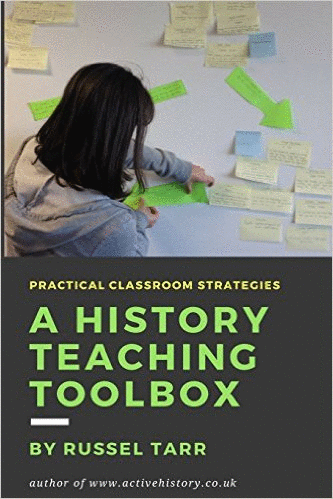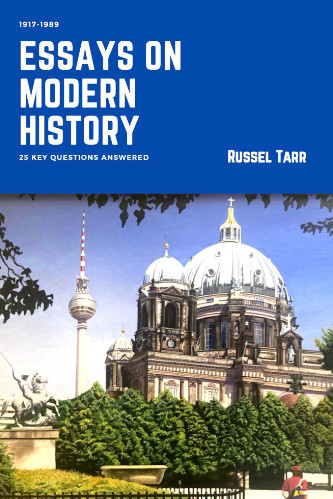This unit forms part of the World War One materials at ActiveHistory:

Causes of World War One
Life in the Trenches in World War One
Causes for Germany's Defeat in World War One
Remembrance Day: Activities for all Year Groups
Battlefields Trip: itinerary, workpack and follow-up activities
Origins of WW1 and WW2: Comparisons and Contrasts
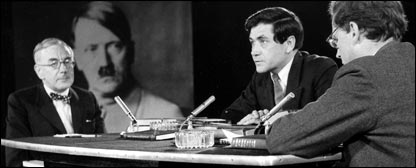 In this unit, students will have the opportunity to research the origins of both World War One, and World War Two, in considerable depth. The unit is structured so that the factor to be researched are directly comparable. One group of students will focus on the First World War, and one on the Second World War. They will present their findings to each other, and then conduct follow-up activities based around some of the big historiographical debates (e.g. the Fischer Controversy, the Structuralist/Intentionalist debate, the Taylor/Trevor-Roper clash - pictured - about whether Hitler was a 'Gambler' or a 'Planner'). Finally, they will be in a position to compare and contrast the origins of both wars and produce a detailed and sophisticated essay.
In this unit, students will have the opportunity to research the origins of both World War One, and World War Two, in considerable depth. The unit is structured so that the factor to be researched are directly comparable. One group of students will focus on the First World War, and one on the Second World War. They will present their findings to each other, and then conduct follow-up activities based around some of the big historiographical debates (e.g. the Fischer Controversy, the Structuralist/Intentionalist debate, the Taylor/Trevor-Roper clash - pictured - about whether Hitler was a 'Gambler' or a 'Planner'). Finally, they will be in a position to compare and contrast the origins of both wars and produce a detailed and sophisticated essay.
This unit is best followed by the "Origins of War Historiography Project" that can also be found on ActiveHistory.
Stage 1: Researching each war in depth
Historiographical Overview: This information sheet outlines the essential historiographical debate - namely, the Fischer Thesis, which suggested that both World Wars were essentially caused by the same consistent factor - namely, German aggression. The task of students will be to decide how far they agree with this idea.
Research Template: Students are then presented with a research template which has NINE key causes of each World War listed within it. "Divide these causes between the members of the group.Research your allocated factor(s) with relation to your particular war. Produce a one-slide presentation which will summarise your findings for the rest of the class".
Additional resources for students researching the Origins of World War One
- Summary Sheet - A summary of the main events, organised by theme; there is also a factual test based on this (note: requires teacher password).
- Main Video Resource: The Great War (1964), Episode 1 - with accompanying worksheet and also a factual test (note: requires teacher password).
Additional resources for students researching the Origins of World War Two
- Main Video Resource: The Nazis: A Warning from History, Episode 3 - with accompanying worksheet.
Stage 2: Presentations
Overview of the procedure: This handout explains how the group working on World War One will present their findings first, and that this will be followed by a whole-class exercise linking the factors together and some historiography work (below). The same format is repeated with relation to World War Two.
Historiography of World War One: Follow-up work after the presentations and linkage of factors
- Introductory video clip: AJP Taylor outlines his "railway timetable" theory - do we find it convincing?
- Main Task: Historiography through events management: Design a Seating Plan for these 18 Historians!
 (pictured)
(pictured)
"Here are 18 historians with different viewpoints about the Origins of World War One. Your job is to cut up these cards, read each one carefully, and arrange a dinner party reception designed to ensure that nobody ends up sitting adjacent to anybody that they will argue with too much, but will instead sit adjacent next to somebody or several people that they broadly agree with! Work alone at first, then compare your ideas with a partner and with the class. Stick down your cards on sugar paper when you are happy with your seating plan, and provide a key to explain why each ‘table’ has been arranged in that particular way".
Discussion points: (a) Where would you seat yourself, and why? (b) If a fight was to break out between two tables of people - or two key individuals - which would they be, and why? (sample piece of work shown below)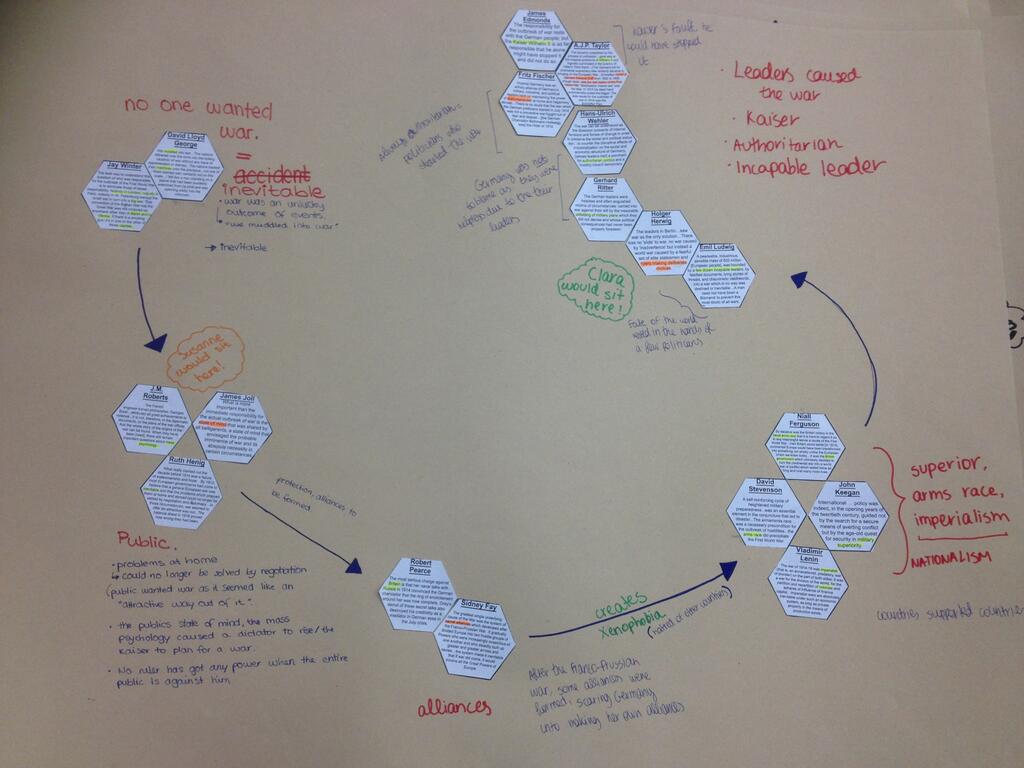
- Factual test on WW1
This factual test could be taken by students at this stage to test their knowledge and understanding of the topic by this stage. Questions are divided into chronological, thematic and historiographical categories (30 questions in total).
Historiography of World War Two: Follow-up work after the presentations and linkage of factors
- Introductory video clip: AJP Taylor and Hugh Trevor-Roper debate whether Hitler was a 'Gambler' or a 'Planner' (this clip is best shown after introducing students to the worksheet that follows - it is directly referenced within it towards the beginning).
- Main Task: Was Hitler a Gambler, or a Planner, in Foreign Affairs?
Students use extracts from the 4-Year Plan, Code Green, the Hossbach Memorandum and Mein Kampf to decide where they stand in the classic Taylor/Trevor-Roper debate about the "Hitler Factor". They can then write up their findings. As an extension task they could investigate the Intentionalist/Structuralist debate. - Extension Task: Was Appeasement Spineless, Stupid, Cunning or Honourable?
If you are keen that students cover the Origins of World War Two from all of the essential angles, the following materials allow students to conduct an in-depth analysis of the efficacy of appeasement as a policy by the British and the French in the interwar period.
Stage 3: Comparing and contrasting both wars
Introductory video clip: AJP Taylor outlines the "Fischer Controversy"
With both wars now considered separately, we are in a position to judge whether the "Fischer Thesis" (that both wars can primarily be explained through reference to a consistently aggressive German foreign policy) is accurate.
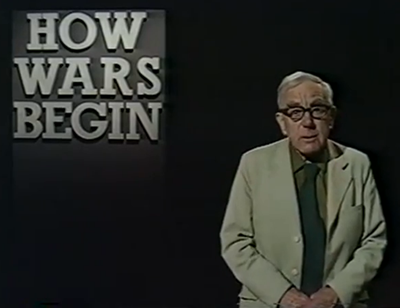
Main Task: Was Hitler's foreign policy traditional, or unprecedented?
In this activity students use extracts from the Treaty of Brest-Litovsk, an Interview with Hitler, Mein Kampf and the September Programme to decide where they stand in regard to the Fischer controversy.
Model Essay by RJ Tarr (note: teacher password required)
At this point, students should return to their original research template to complete the final column, which asks them to make some observations about whether the various factors for each war are areas of comparison and contrast. This can then be used as the basis for an essay on the causes of either war, or an essay comparing them both. The model essay provided here was written by the author of this website in timed conditions and could be given to students for extra stimulus after they have finished their own work.

© 1998-2025 Russel Tarr, ActiveHistory.co.uk Limited (Reg. 6111680)
1 Torrin Drive, Shrewsbury, Shropshire, SY3 6AW, England
Privacy Policy | Contact


